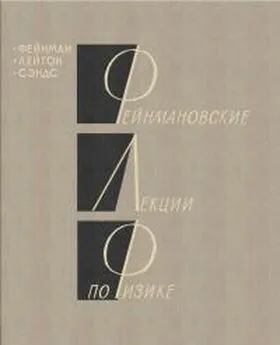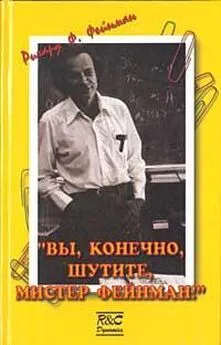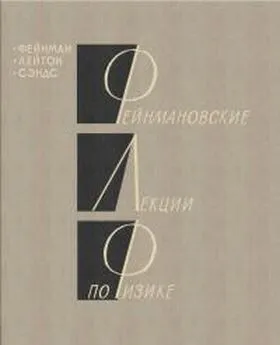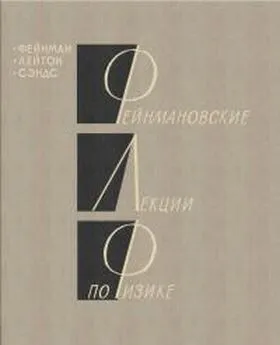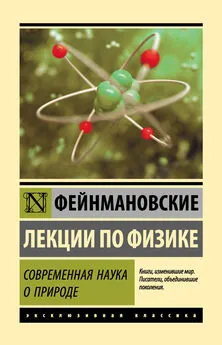Ричард Фейнман - Том 2. Электромагнетизм и материя
- Название:Том 2. Электромагнетизм и материя
- Автор:
- Жанр:
- Издательство:неизвестно
- Год:неизвестен
- ISBN:нет данных
- Рейтинг:
- Избранное:Добавить в избранное
-
Отзывы:
-
Ваша оценка:
Ричард Фейнман - Том 2. Электромагнетизм и материя краткое содержание
Том 2. Электромагнетизм и материя - читать онлайн бесплатно полную версию (весь текст целиком)
Интервал:
Закладка:
Есть такие люди, которые будут очень расстроены, если на других планетах не будет найдено жизни. Я не принадлежу к их числу. И я никогда не смогу перестать удивляться и радоваться результатам межпланетных исследований, обнаруживающих бесконечное разнообразие и новизну явлений, порожденных одними и теми же самыми простыми принципами. Критерий науки — ее способность предсказывать. Могли бы вы предсказать бури, вулканы, океанские волны, зори и красочные закаты, если бы вы никогда не были на Земле?
Драгоценным сокровищем для нас будет все, что мы узнаем о происходящем на каждой из мертвых планет, каждого из десятка шаров, образовавшихся из того же самого облака пыли и подчиняющихся тем же самым законам физики, что и наша планета.
Грядущая великая эра пробуждения человеческого разума принесет с собой метод понимания качественного содержания уравнений. Сегодня еще мы не способны на это. Сегодня мы не можем увидеть в уравнениях потока воды такие вещи, как спиральное строение турбулентности, которую мы видим между вращающимися цилиндрами. Сегодня мы не можем сказать с уверенностью, содержит ли уравнение Шредингера и лягушек, и композиторов, и даже мораль или там ничего похожего и быть не может. Мы не можем сказать, требуется ли что-либо сверх уравнения, вроде каких-то богов, или нет. Поэтому каждый из нас может иметь на этот счет свое особое мнение.
ПРИЛОЖЕНИЕ (к главе 30)
A dynamical model of a crystal structure [62] Здесь воспроизведены лишь первые четыре параграфа статьи из Proceedings of the Royal Society of London , Vol. 190, p. 474 (1947). Нумерация листов, на которых размещены рисунки, в оригинале и переводе не совпадают. Литература, приведенная в конце статьи, дана в переводе в подстрочных примечаниях.— Прим. ред .
by sir Lawrence Bragg, F.R.S. and J. F. Nye Cavendish Laboratory, University of Cambridge
( Received 9 January 1947— Read 19 June 1947) [Plates 8 to 21]
The crystal structure of a metal is represented by an assemblage of bubbles, a millimetre or less in diameter, floating on the surface of a soap solution. The bubbles are blown from a fine pipette beneath the surface with a constant air pressure, and are remarkably uniform in size. They are held together by surface tension, either in a single layer on the surface or in a threedimensional mass. An assemblage may contain hundreds of thousands of bubbles and persists for an hour or more. The assemblages show structures which have been supposed to exist in metals, and simulate effects which have been observed, such as grain boundaries, dislocations and other types of fault, slip, recrystallization, annealing, and strains due to 'foreign' atoms.
1. The bubble model
Models of crystal structure have been described from time to time in which the atoms are represented by small floating or suspended magnets, or by circular disks floating on a water surface and held together by the forces of capillary attraction. These models have certain disadvantages; for instance, in the case of floating objects in contact, frictional forces impede their free relative movement. A more serious disadvantage is that the number of components is limited, for a large number of components is required in order to approach the state of affairs in a real crystal. The present paper describes the behaviour of a model in which the atoms are represented by small bubbles from 2.0 to 0.1 mm. in diameter floating on the surface of a soap solution. These small bubbles are sufficiently persistent for experiments lasting an hour or more, they slide past each other without friction, and they can be produced in large numbers. Some of the illustrations in this paper were taken from assemblages of bubbles numbering 100,000 or more. The model most nearly represents the behaviour of a metal structure, because the bubbles are of one type only and are held together by a general capillary attraction, which represents the binding force of the free electrons in the metal. A brief description of the model has been given in the Journal of Scientific Instruments (Bragg 1942b).

figure 1. Apparatus for producing rafts of bubbles.
2. Method of formation
The bubbles are blown from a fine orifice, beneath the surface of a soap solution. We have had the best results with a solution the formula of which was given to us by Mr. Green of the Royal Institution. 15-2 c.c. of oleic acid (pure redistilled) is well shaken in 50 c.c. of distilled water. This is mixed thoroughly with 73c.с. of 10% solution of tri-ethanolamine and the mixture made up to 200 c.c. To this is added 164 c.c. of pure glycerine. It is left to stand and the clear liquid is drawn off from below. In some experiments this was diluted in three times its volume of water to reduce viscosity. The orifice of the jet is about 5 mm. below the surface. A constant air pressure of 50 to 200cm. of water is supplied by means of two Winchester flasks. Normally the bubbles are remarkably uniform in size. Occasionally they issue in an irregular manner, but this can be corrected by a change of jet or of pressure. Unwanted bubbles can easily be destroyed by playing a small flame over the surface. Figure 1 shows the apparatus. We have found it of advantage to blacken the bottom of the vessel, because details of structure, such as grain boundaries and dislocations, then show up more clearly.
Figure 2, plate 8, shows a portion of a ' raft' or two-dimensional crystal of bubbles. Its regularity can be judged by looking at the figure in a glancing direction. The size of the bubbles varies with the aperture, but does not appear to vary to any marked degree with the pressure or the depth of the orifice beneath the surface. The main effect of increasing the pressure is to increase the rate of issue of the bubbles. As an example, a thick-walled jet of 49μ bore with a pressure of 100cm. produced bubbles of 1-2 mm. in diameter A thin-walled jet of 27μ diameter and a pressure of 180cm. produced bubbles of 0.6 mm diameter It is convenient to refer to bubbles of 2.0 to 1.0mm. diameter as 'large' bubbles, those from 0.8 to 0.6mm. diameter as 'medium' bubbles, and those from 0.3 to 0.1 mm. diameter as 'small' bubbles, since their behaviour varies with their size.

figure 3. Apparatus for producing bubbles of small size.
With this apparatus we have not found it possible to reduce the size of the jet and so produce bubbles of smaller diameter than 0.6 mm. As it was desired to experiment with very small bubbles, we had recourse to placing the soap solution in a rotating vessel and introducing a fine jet as nearly as possible parallel to a stream line. The bubbles are swept away as they form, and under steady conditions are reasonably uniform. They issue at a rate of one thousand or more per second, giving a high-pitched note. The soap solution mounts up in a steep wall around the perimeter of the vessel while it is rotating, but carries back most of the bubbles with it when rotation ceases. With this device, illustrated in figure 3, bubbles down to 0.12 mm. in diameter can be obtained. As an example, an orifice 38μ across in a thin-walled jet, with a pressure of 190cm. of water, and a speed of the fluid of I80cm./sec. past the orifice, produced bubbles of 0.14 mm. diameter. In this case a dish of diameter 9-5 cm. and speed of 6 rev./sec. was used. Figure 4, plate 8, is an enlarged picture of these 'small' bubbles and shows their degree of regularity; the pattern is not as perfect with a rotating as with a stationary vessel, the rows being seen to be slightly irregular when viewed in a glancing direction.
These two-dimensional crystals show structures which have been supposed to exist in metals, and simulate effects which have been observed, such as grain boundaries, dislocations and other types of fault, slip, recrystallization, annealing, and strains due to ' foreign' atoms.
3. Grain boundaries
Figures 5a, 56 and 5c, plates 9 and 10, show typical grain boundaries for bubbles of 1.87, 0.76 and 0.30 mm. diameter respectively. The width of the disturbed area at the boundary, where the bubbles have an irregular distribution, is in general greater the smaller the bubbles. In figure 5a, which shows portions of several adjacent grains, bubbles at a boundary between two grains adhere definitely to one crystalline arrangement or the other. In figure 5с there is a marked ' Beilby layer' between the two grains. The small bubbles, as will be seen, have a greater rigidity than the large ones, and this appears to give rise to more irregularity at the interface.
Separate grains show up distinctly when photographs of polycrystalline rafts such as figures 5 a to 5c, plates 9 and 10, and figures 12a to 12e, plates 14 to 16, are viewed obliquely. With suitable lighting, the floating raft of bubbles itself when viewed obliquely resembles a polished and etched metal in a remarkable way.
It often happens that some 'impurity atoms', or bubbles which are markedly larger or smaller than the average, are found in a polycrystalline raft, and when this is so a large proportion of them are situated at the grain boundaries. It would be incorrect to say that the irregular bubbles make their way to the boundaries; it is a defect of the model that no diffusion of bubbles through the structure can take place, mutual adjustments of neighbours alone being possible. It appears that the boundaries tend to readjust themselves by the growth of one crystal at the expense of another till they pass through the irregular atoms.
4. Dislocations
Интервал:
Закладка:
